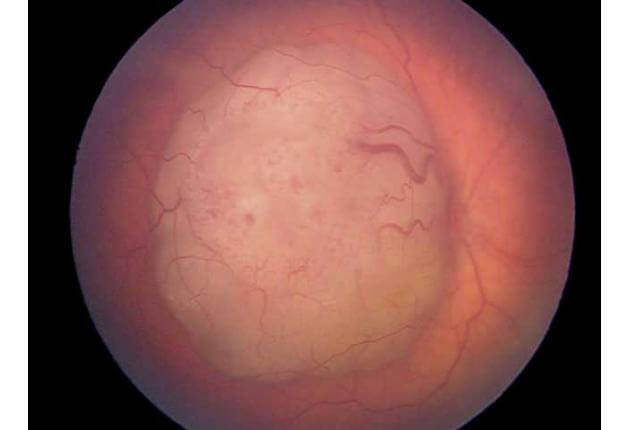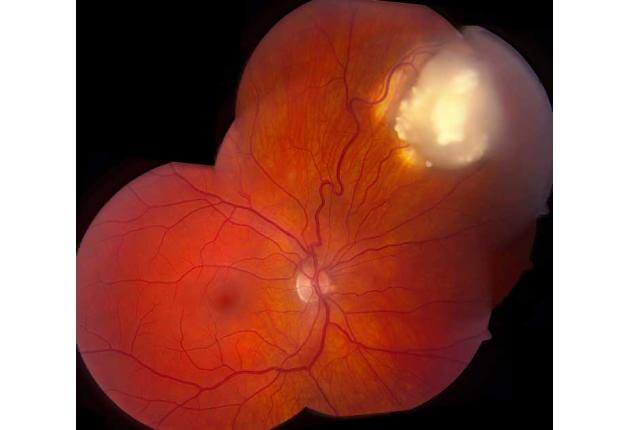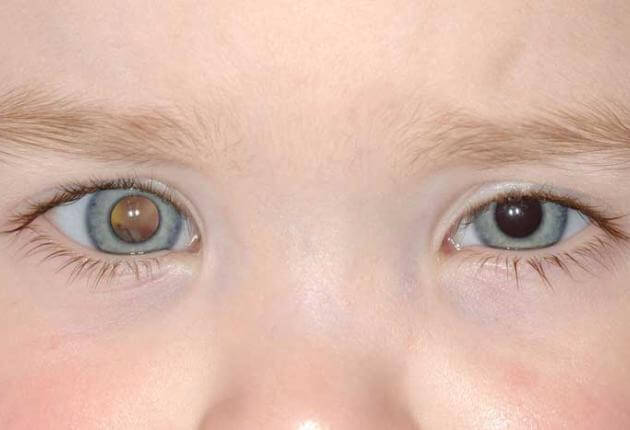Retinoblastoma
Retinoblastoma is the leading eye cancer in infants and children. Early diagnosis and treatment is important for preventing metastasis and death of the child and additionally preserving the eye and vision. Other cancers can later occur in these children including pinealoblastoma, osteosarcoma, and melanoma. This pediatric cancer can be inherited from an affected parent who has retinoblastoma so it is important to examine all newborns of parents with retinoblastoma. There are approximately 250-300 children in the USA affected with this cancer each year and the Oncology Service at Wills Eye Hospital examines and provides treatment to 125 of these children. So nearly 50% of all children with retinoblastoma in the USA are managed at Wills Eye.
The diagnosis of retinoblastoma is made by an experienced eye doctor recognizing the classic features of retinoblastoma using indirect ophthalmoscopy. There are many eye conditions that can occur in children so the doctor must be confident that the child has a cancer before starting potentially serious treatments. This is important as the diagnosis must be correct before starting chemotherapy or radiotherapy. There are several tests that help to confirm retinoblastoma including ocular ultrasonography, fluorescein angiography, photographic imaging, optical coherence tomography, computed tomography, and magnetic resonance imaging.
Several treatments are used for management of retinoblastoma, including enucleation, chemotherapy, and radiotherapy. Enucleation is removal of the eye and it is used for advanced retinoblastoma when the cancer has destroyed the eye and there is no hope for sight. It is also used for recurrent retinoblastoma after other methods have failed. Immediately following surgical removal of the eye, a motility implant is placed and tissue closed for healing for 6 weeks. Later, at 6 weeks, an artificial eye (prosthesis) is designed and provides a natural appearance and motility for these young children.
Chemotherapy is also used to treat retinoblastoma. There are several techniques for delivering the chemotherapy. In some instances the chemotherapy is given for 6 months by intravenous route (chemoreduction), particularly if there are multiple tumors in both eyes. In other cases chemotherapy is delivered by 3 sessions over 3 months by intra-arterial route (intra-arterial chemotherapy), particularly if the cancer is only in one eye and there is some hope for sight. In yet other cases chemotherapy is injected into the eye or around the eye. Each method has specific benefits and complications and the method used depends on the overall appearance of the tumor. Most children show a successful response to chemotherapy with salvage of the eye and preservation of some vision.
Radiotherapy can be used for retinoblastoma. This can be delivered by either plaque radiotherapy where a device is placed directly on the eye for 5 days to cure the cancer or it can be delivered by external beam radiotherapy where a child receives daily treatments over 20 days.
The management of retinoblastoma requires extensive experience with the various techniques and understanding of expected outcomes. All children are tested for genetic mutations and followed long-term for related second cancers. In the long run, most children with retinoblastoma do quite well.




